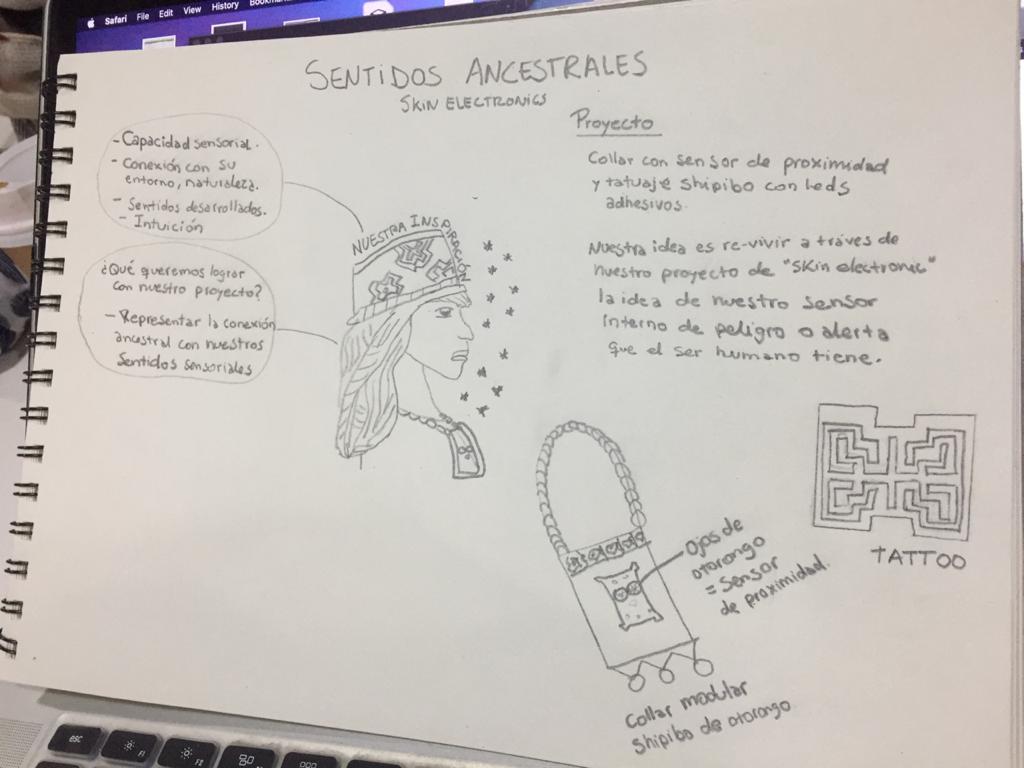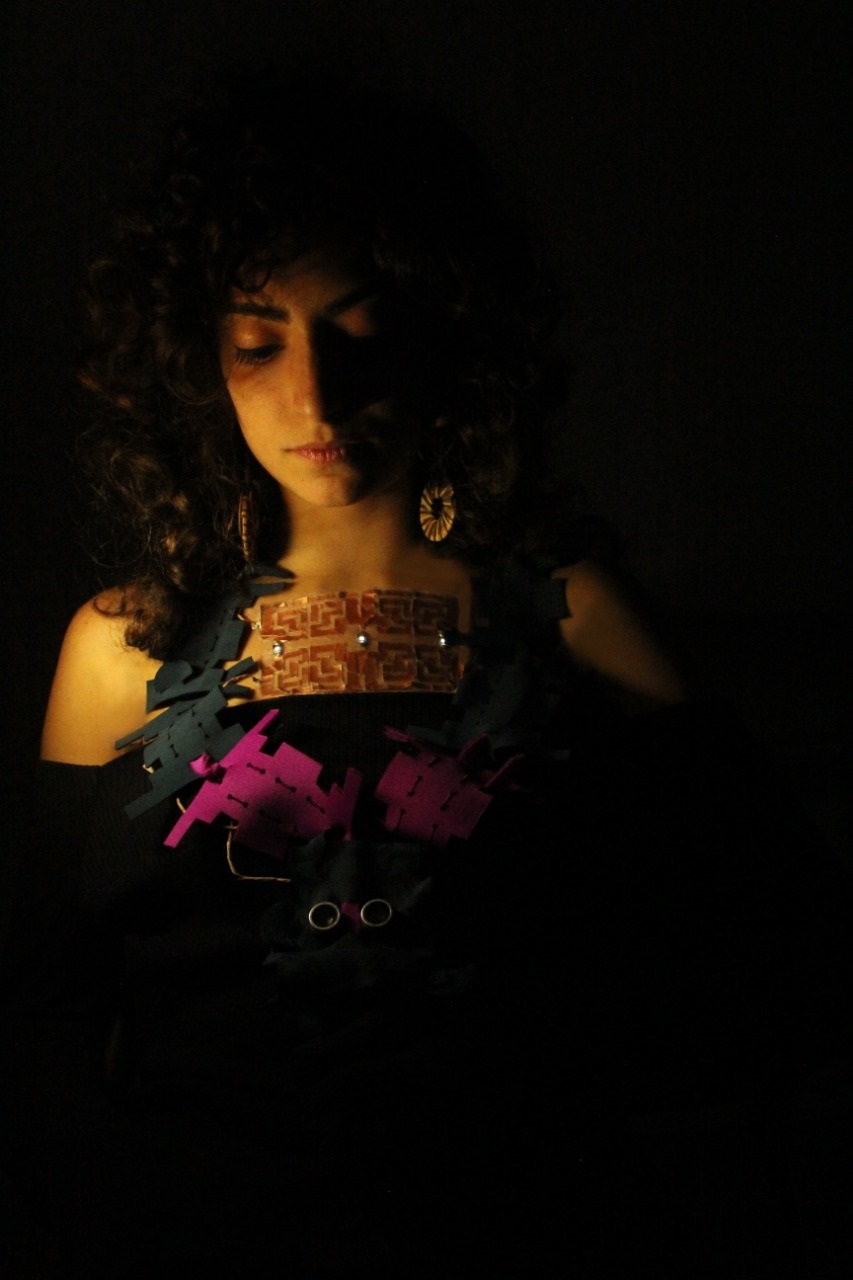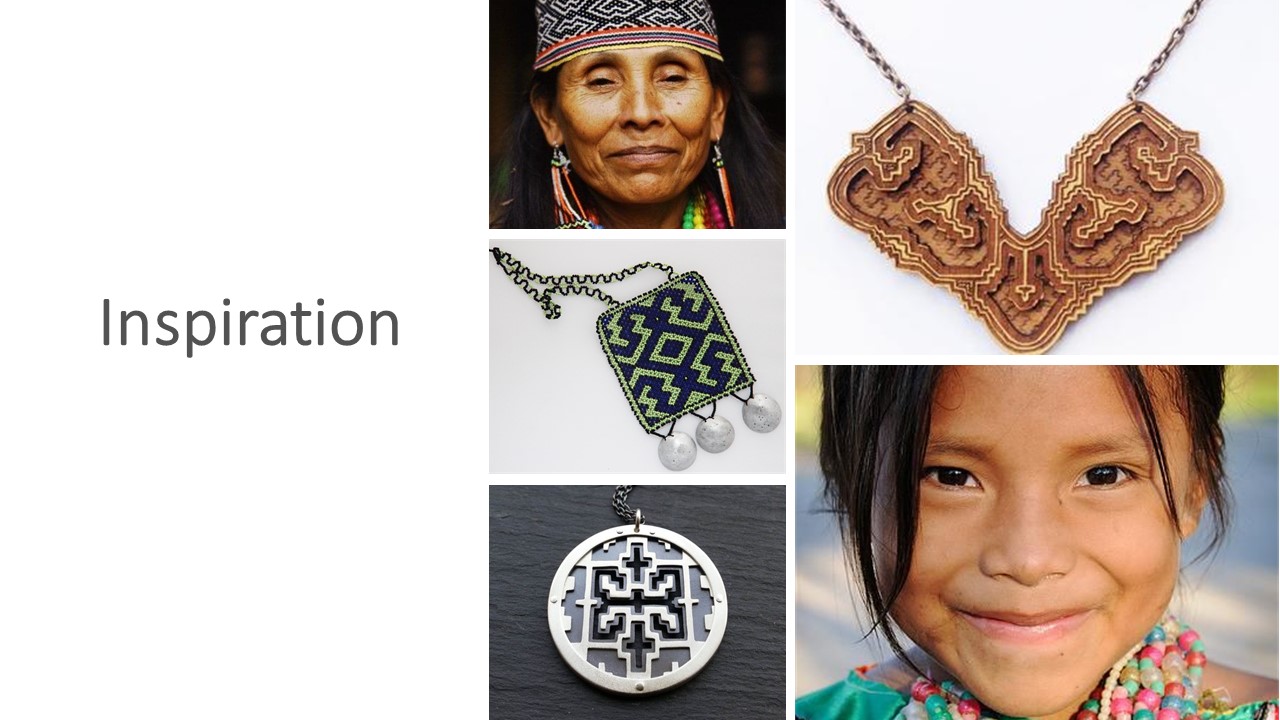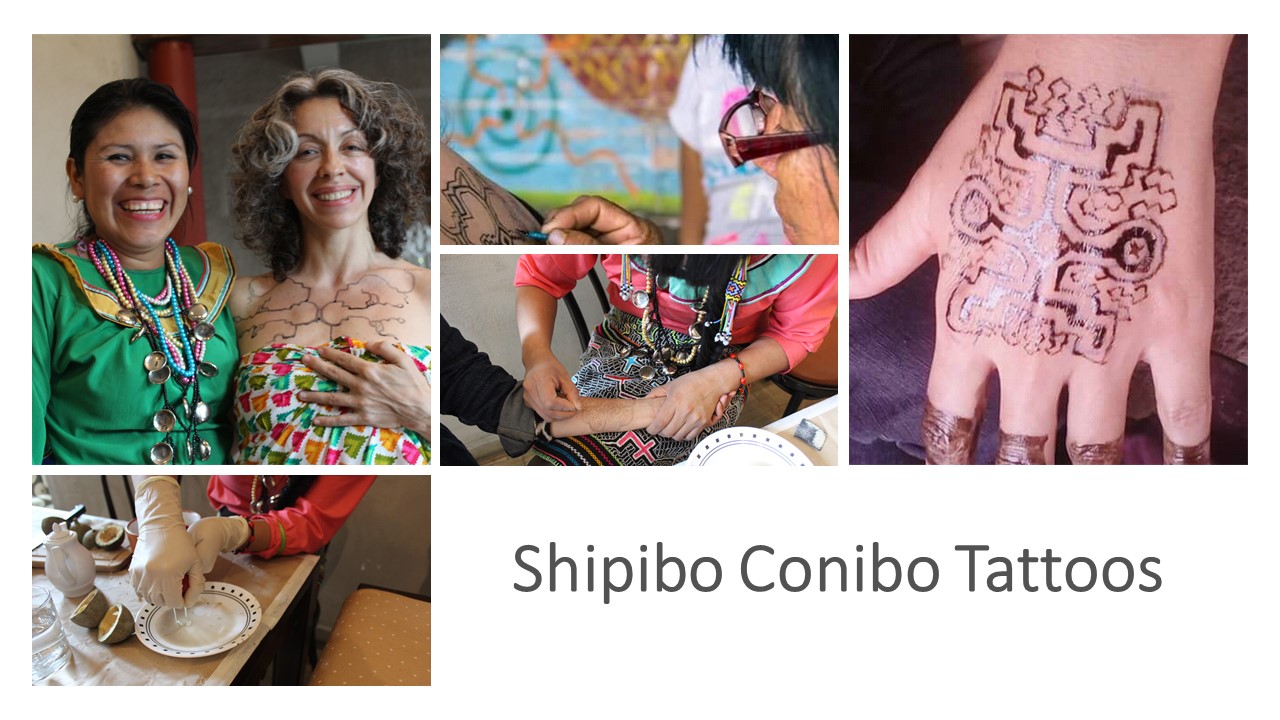13. Skin Electronics¶
The project will consist in two accesories that are interconnected by a distance sensor. A necklace which will contain a distance ultrasonic sensor such as HC-SR04 and a tattoo or bracelet located by one of the forearms. Main features to be achieved will be HUMAN AWARENESS of natural sorroundings and danger. Basically the tattoo will lightup everytime a natural organism or another human is near by.

The Inspiration¶
Main inspiration is the close connection with nature and sorroundings that native cultures around the world had. One of them is Shipibo Conibo
whom were capable to create amazing KENE patterns that represented their cosmovision and were manifested in their paintings, tattoos, embroidery,
jewerly and music.
According to Amazonian thought, the universe presents vitality and is animated. Thus, every material or physical entity has its spiritual
counterpart, which it usually has human form, although generally, human beings perceive only the apparent manifestations of material reality,
a diversity of invisible beings act and interact behind or within it, so that the appearance constitutes akind of wrap. Among the notions about the dynamics of life,
are the homologation of the facts of nature and those of social life, also the existence of a universal network that links the superworld
and underworld with the ecosystem and with human society.
On our days our wide biodiversity is in danger..the Amazonian Jaguar or Leopard has been used in Ayahuasca Rituals putting in danger this beautiful animal.
There is evidence of a growing trade in jaguar body parts across Latin America, particularly in Brazil, Bolivia, Suriname, Costa Rica, and Peru. With Latin America's current
ayahuasca and shamanic tourist boom there are additional demands for jaguar products. Each year, thousands of ayahuasca tourists travel to Peru, generating
significant revenue for retreat centers that administer the brew. Therefore this project also wants to sensibilize people about wildlife's respect and preservation.
Research¶
The Shipibo-Conibo or Shipibo-Konibo people is an ethnic group of the Peruvian Amazon that is distributed on the banks of the Ucayali River in Pucallpa, Peru. The heart of the Shipibo culture is based on its spiritual, physical and cultural relationship with the jungle and KENE expression of art of this community is a fusion of form, light and sound that is transmitted from mother to daughter. Their designs are translated into tunes or ICARUS, where each design has its own melody. Shipibo Conibo Tattoos and Jewerly are part of their identity and statement and they are inspired in their cosmovision and there is an ancestral knowledge behind, which has been transmitted from generation to generation.
Shipibo Conibo: Jewerly and Temporary Tattoos Interesting Facts:¶
-Tattoos generate biodegradable waste (gray water).¶
-Made with natural pigments that are made with a native fruit called Huito.¶
-Tattoos do not involved micro punctures on the skin. They are superficial.¶
-They last for approx. 2 weeks. Therefore, minimum human´s health hazards and environmental impact.¶
-Tattoos are 2D designs and mostly geometric and lineal.¶
-Traditional jewelry was made with natural seeds and fibers. Contemporary designs are made with beads, but they maintain their designs and amazing econometry.¶
Materials and Tools¶
-1 x Adafruit FLORA board/ Lily Pad Board¶
-1 x Coincell battery holder¶
-DEV 13902 Lily PAD LEDs¶
-Distance Ultrasonic Sensor HC-SR04¶
-03 AA Batteries¶
-Thin Wires (insulated copper thin wire or silicone)¶
-MCN UV80 Solder Paste Flux¶
-Tweezers¶
-Wire strippers, flush snips, and tweezers¶
-E6000 craft glue¶
-Forearm, Necklace or Bracelet Shipibo Conibo Tattoo (made with mold prepared in Soft Robotics Class)¶
-Fixomull Transparent Surgical Tape¶
-3M Micropore Professional Care Adhesive Tape for Sensitive Skins¶
-Multimeter¶
Electrical Circuit Sketchboard¶


Distance Ultrasonic Sensor HC-SR04 Circuit/ Lilypad LED ARDUINO code¶
#define trigPin 10
#define echoPin 9
#define led 6
void setup()
{ Serial.begin (9600);
pinMode(trigPin, OUTPUT);
pinMode(echoPin, INPUT);
pinMode(led, OUTPUT);
}
void loop()
{ long duracion, distancia ;
digitalWrite(trigPin, LOW); // Nos aseguramos de que el trigger está desactivado
delayMicroseconds(2); // Para asegurarnos de que el trigger esta LOW
digitalWrite(trigPin, HIGH); // Activamos el pulso de salida
delayMicroseconds(10); // Esperamos 10µs. El pulso sigue active este tiempo
digitalWrite(trigPin, LOW); // Cortamos el pulso y a esperar el echo
duracion = pulseIn(echoPin, HIGH) ;
Serial.println(String(duracion) + "dura");
distancia = duracion / 2 / 29.1 ;
Serial.println(String(distancia) + " cm.") ;
int Limite = 20 ; // Medida en vacío del sensor
if ( distancia < Limite)
digitalWrite ( led , HIGH) ;
else
digitalWrite( led , LOW) ;
delay (500) ; // Para limitar el número de mediciones
}
Circuit Assemble Process¶
Ultrasonic Sensor Tests¶
Main Conclusions¶
- Verify the settings of the vynil or adhesive paper cutter, which, should be set according to the conductive material you will use for your e-skin project.
- Don't laser cut conductive paper.
- Always verify the materials and tools's datasheet of you will use.
- When assembling your final circuit always test that the energy supply is working by using the multimeter or connecting the proper energy supply that is required. In our case the Lily Pad LEDS where conected in parallel and required 3.3V, while the FLORA Adafruit can handle a USB input of 4.5 to 5V, but has an output of 3.3V. Therefore we opted for 3 AA batteries for a main energy supply, which could be distributed from FLORA Adafruit to the Ultrasonic Distance Sensor and Lily Pad LEDS.
Useful links¶
- Distance Ultrasonic Sensor HC-SR04 Circuit
- Lilypad LED White
- MCN-UV80 No-clean Solder Paste Flux Soldering
- Lily Pad 0603 LED Lights
- Skintillates Paper
- DuoSkin Paper
- Field Museum Exhibition
- The history of tattoos - Addison Anderson
- Shipibo: Territorio, Historia y Cosmovision
- The ayahuasca tourism boom: An undervalued demand driver for jaguar body parts?
- Tourism Boom for Ayahuasca
Main References¶
Catherine Euale Cleopatra Headdress¶
Jessica Stanley - Touch Sensor on Skin¶
DUO Skin¶
Skintillates¶
Skintillates: Designing and Creating Epidermal Interactions from Eric Paulos on Vimeo.
Ultrasonic Sensor Arduino Tutorial¶
HC-SR04 Ultrasonic Ping Sensor - Arduino Tutorial from Treehouse Projects on Vimeo.
Code Example¶
Videos & Pictures of FINAL SKIN ELECTRONICS PROJECT¶

Skin Electronics Ancestral Sensor from Majavierr on Vimeo.
Skin Electronics Final Project¶
Skin Electronic - Ancestral Senses from Estefania Cavalie on Vimeo.


